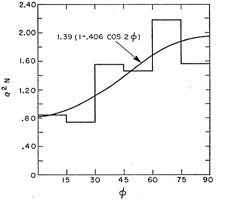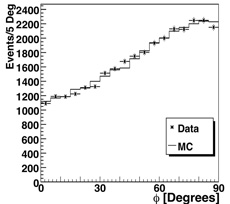KTeV directly measures neutral pion parity

 |
| The angular distribution of the decay of a neutral pion to two electrons and
two positrons. Left: The distribution published by N.P. Samios et al. in
1962. Right: The distribution obtained by KTeV. The solid line is the
prediction for negative parity. |
The parity of a particle is one of its fundamental quantum properties. Its value, like electric charge, can be either positive or negative. Parity also describes the difference between your left hand and your right hand: the reflection of your left hand in a mirror is identical to your right hand.
When a subatomic reaction remains unchanged when watched in a mirror, the total parity of this system of particles is conserved. According to the Standard Model, reactions involving the strong and electromagnetic forces conserve parity; reactions involving the weak force do not.
The KTeV collaboration at Fermilab, using data collected from 1997 to 2000, has now obtained the world's best result on the parity of the neutral pion. Pions are particles that act as the glue that holds protons and neutrons together in a nucleus. The Standard Model predicts and indirect measurements have indicated that neutral pions have negative parity. KTeV's direct measurement now conclusively confirms the negative parity of the neutral pion with over 20 standard deviations.
The direct measurement of the neutral pion's parity is difficult. The only known method relies on the decay of a pion to two electrons and two positrons, also known as the "double Dalitz" decay (named after the late physicist Richard Dalitz, who first predicted this class of decays). Each electron forms a "Dalitz pair" with one of the positrons, and each pair represents a two-dimensional plane in space, defined by the directions of the two particles. If the pion has negative parity, the planes of the two Dalitz pairs will be perpendicular to each other more often than they are parallel. If the pion has positive parity, the planes will prefer to be parallel.
The double Dalitz decay rarely occurs: only one pion in 30,000 decays in this way. Prior to the KTeV experiment, the last measurement of this decay was in 1962 when a bubble chamber at Columbia University's Nevis Cyclotron recorded 200 "double Dalitz" events. Based on 112 analyzable events, the experimenters at Columbia found that the data favored negative parity with a statistical significance of three to four standard deviations. Their result has been one of the oldest results in high-energy physics that physicists had not been able to improve upon.
The KTeV collaboration recorded 30,500 analyzable "double Dalitz" events. It analyzed the data using its own detailed model of radiative corrections to account for two subtle effects. First, photons emitted by the electrons can change the angular distributions of the decay products and hence rotate the planes defined by the Dalitz pairs; second, an ambiguity exists in assigning each electron to a positron to form a Dalitz pair.
KTeV's measurement of the angle between the two planes is in precise agreement with the Standard Model. The experiment also yields the world's best measurement of the double Dalitz decay rate and sets tight limits on any parity violating contributions to the decay. If CPT symmetry is conserved, those contributions must be less than 3.3 percent.
KTeV is now one step closer to its goal of having the world's best results on all known decay modes of the neutral pion.

|
| Left to right: Tony Barker (deceased), Patrick Toale
and Eric Zimmerman of the University of Colorado. |
Read the associated paper
Result of the Week Archive
|